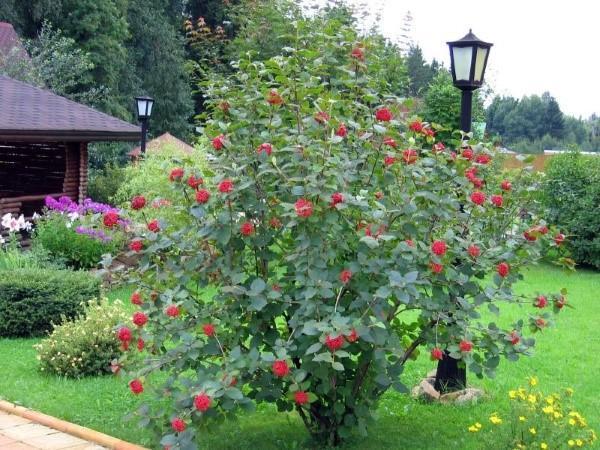Growing viburnum in the garden - what you need to know about planting and caring for a plant
 Many gardeners are interested in cultivating viburnum, because this shrub is not only useful, but also very beautiful. A lush crown with large green leaves in spring is decorated with delicate white inflorescences. In the fall, bright red clusters ripen in their place, and the leaves themselves acquire a charming burgundy blush. How to get this shrub on the site and what does he like?
Many gardeners are interested in cultivating viburnum, because this shrub is not only useful, but also very beautiful. A lush crown with large green leaves in spring is decorated with delicate white inflorescences. In the fall, bright red clusters ripen in their place, and the leaves themselves acquire a charming burgundy blush. How to get this shrub on the site and what does he like?
Where is it better to plant viburnum
Kalina is one of those perennials that feels great in partial shade. Bright areas exposed to the sun during the day are best left for other, more sun-loving crops. For viburnum, an excess of the sun is even harmful, but in partial shade the bush will always be covered with lush green greenery.
Another advantage of viburnum is that over time, the crown of the bush grows strongly. Lush dense bush will cover unsightly areas in the form of an old fence or outbuildings.
As for the soil, viburnum prefers and grows better on moist nutrient lands with an acidity of about 5.5 pH.
How to plant viburnum
Most often, the plant appears on the site in the form of a young seedling. Viburnum is a common plant, and there will be no problems with its purchase. Not everyone likes to tinker with seeds or cuttings, and purchasing a seedling will avoid the hassle and get a ready-made young bush.
You can plant viburnum in spring or autumn by digging a planting hole about 50x50 cm in size.The root collar must be slightly deepened a couple of centimeters below the soil level. The planted bush should be well watered. So that moisture does not evaporate quickly - mulch, for example, crushed bark.
To provide the growing bush with food, it is advisable to add a bucket of rotted humus to the bottom of the planting pit. It must be mixed with the earth in the hole so as not to burn the roots, and only then install the seedling,
Growing viburnum: the basics of caring for a shrub
Viburnum is a moisture-loving plant, because it is not for nothing that she prefers shady places. Therefore, one of the most important maintenance measures is regular watering, at least 2 times a week.
In addition, viburnum needs:
- Feed. In the spring, nitrogen preparations are used to stimulate growth. From the second half of summer, in order to get a harvest of medicinal berries, they switch to potassium-phosphorus fertilizers.
- Form. Viburnum grows in the form of a bush and you can leave this form, thinning the crown annually. Another perennial is formed in the form of a tree, leaving one shoot and cutting out the rest. For several years, the trunk is grown, and when it reaches a height of about 1 m, the crown of the tree begins to form.
As you can see, the cultivation of viburnum will not cause much trouble, but it will delight you with a beautiful shrub and a medicinal harvest.